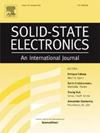新颖的y函数方法参数估计由弱到强的反演运算
IF 1.4
4区 物理与天体物理
Q3 ENGINEERING, ELECTRICAL & ELECTRONIC
引用次数: 0
摘要
提出了一种新的y函数方法,用于从弱反转到强反转的栅极电容比估计。根据漏极电流在线性工作状态下的表达式和经典迁移率定律,通过求解二阶方程,证明了从弱反转到强反转时栅极电容比上的反转电荷无需任何近似即可估计。后一个方程主要取决于y函数和需要提取的三个参数,两个在强反演中(增益因子GM和二阶迁移率衰减因子θ2),一个在亚阈值区(亚阈值摆动SS)。这种易于使用的y函数方法可以精确地提取物理意义上的电参数,并通过实验和漏极电流模型以及先进晶体管从弱到强反转工作状态的跨导行为之间的非常好的一致性来证实。本文章由计算机程序翻译,如有差异,请以英文原文为准。
Novel Y-function methodology parameter estimation from weak to strong inversion operation
A new Y-function methodology approach for the inversion charge over the gate capacitance ratio estimation from weak to strong inversion operation has been developed. Based on the drain current expression in the linear operation regime and classical mobility law, it is demonstrated that the inversion charge over the gate capacitance ratio may be estimated from weak to strong inversion operation without any approximation by solving a second-degree equation. This latter equation depends notably on the Y-function and on three parameters which are needed to be extracted, two in strong inversion (the gain factor GM and the second order mobility attenuation factor θ2) and one in subthreshold zone (the subthreshold swing SS). This easy-to-use Y-function approach permits accurate and physical meaning electrical parameter extraction confirmed by the very good agreement between the experimental and the model of the drain current and of the transconductance behavior of advanced transistors from weak to strong inversion operation regime.
求助全文
通过发布文献求助,成功后即可免费获取论文全文。
去求助
来源期刊

Solid-state Electronics
物理-工程:电子与电气
CiteScore
3.00
自引率
5.90%
发文量
212
审稿时长
3 months
期刊介绍:
It is the aim of this journal to bring together in one publication outstanding papers reporting new and original work in the following areas: (1) applications of solid-state physics and technology to electronics and optoelectronics, including theory and device design; (2) optical, electrical, morphological characterization techniques and parameter extraction of devices; (3) fabrication of semiconductor devices, and also device-related materials growth, measurement and evaluation; (4) the physics and modeling of submicron and nanoscale microelectronic and optoelectronic devices, including processing, measurement, and performance evaluation; (5) applications of numerical methods to the modeling and simulation of solid-state devices and processes; and (6) nanoscale electronic and optoelectronic devices, photovoltaics, sensors, and MEMS based on semiconductor and alternative electronic materials; (7) synthesis and electrooptical properties of materials for novel devices.
 求助内容:
求助内容: 应助结果提醒方式:
应助结果提醒方式:


